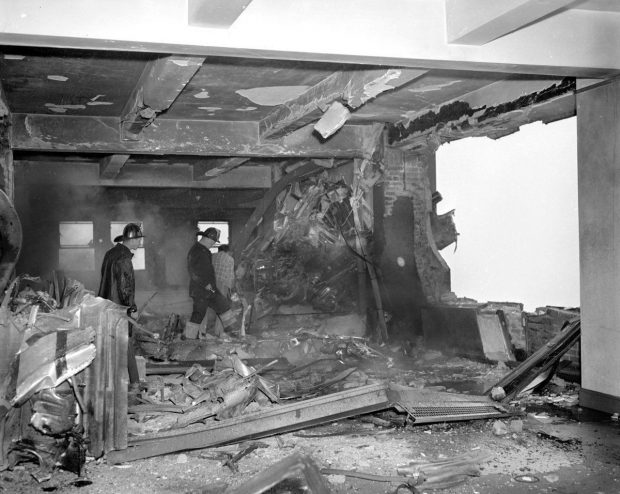
The AP news agency has put a million minutes of historical footage online. Included are the dramatic images of a US bomber hitting the Empire State Building in 1945.
At 34th Street, Manhattan is about 3.5 kilometers wide. At the intersection with Fifth Avenue, the Empire State Building rises 1,250 feet to the roof, narrowing toward the clouds but averaging about 180 feet wide. So, statistically, there is a 1.6 per mille probability that an airplane flying over downtown New York City from northeast to southwest will hit the skyscraper – in other words, the possibility is about 1 in 660.
On July 28, 1945, a foggy Saturday, Lieutenant Colonel William F. Smith Jr. his B-25 twin-engine bomber en route from Massachusetts to New Jersey via New York. Besides him, there were two other passengers on board – it was a routine passenger flight. Nothing special for the 27-year-old pilot, who had more than 500 hours in combat behind him and had won several awards.
READ: Cake Queen: She Baked for the Kennedys, and Donald Trump

An M-25 aircraft was flown by William Franklin Smith Jr. to the Empire State Building on the morning of July 28, 1945
Source: picture-alliance / akg-images
The disaster began when Smith rejected the Tower’s recommendation that North Beach Airport, now known as LaGuardia Airport, be landed northeast of New York immediately because of poor weather conditions. He was determined to carry out his mission to reach Newark Airport, southwest of the city, on time. Because Smith wasn’t a gambler, he wanted to fly over the Hudson River to stay away from the skyscrapers of Manhattan. But that went wrong.
The episodes can be seen in a nearly three-minute film on the Movietone News newsreel, which the AP news agency has now uploaded to YouTube, along with around a million minutes of other historical footage. You can see them for free; advertisements are only occasionally displayed.
It was 9.40 a.m. local time when Smith steered his machine to port in thick fog. But below him lay not, as he probably thought, the Hudson, but the long stretch of Central Park. The disaster took its course – but unlike the attack on the World Trade Center on September 11, 2001, 56 years later, it was an accident.
The disaster was not inevitable. Because the pilot could have pulled his plane up without further ado – there was no longer any danger above 500 meters. But he only flew a good 150 meters high – why could never be clarified.
With difficulty, he was able to dodge the RCA Building, the tallest building in Rockefeller Center between 51st and 48th Streets. Smith actually pulled his B-25 up – but it was too late: the plane gained only about 150 meters in altitude over the one and a half kilometers between Rockefeller Center and the Empire State Building – and crashed at an estimated 320 kilometers per hour at the level of the 79th floor the tallest building in the world at the time.
The medium-weight bomber, which had a maximum take-off weight of 20 tons, tore a 5.50 high and 6.10-meter wide hole in the steel structure of the Empire State Building clad in natural stone. All three occupants of the plane died instantly; the impact and the subsequent fire killed another eleven people in the high-rise building.
READ: Wild Animals Conquer New York: When a Coyote Suddenly Crosses Your Path
One of the engines went through the entire house, shot out on the south side, and destroyed a penthouse on the next block. The other engine and the landing gear behind it fell down an elevator shaft. The entire 79th floor and parts of the adjacent floors were on fire.

The hole in the facade of the Empire State Building
Source: picture alliance / dpa
The 20-year-old elevator operator Betty Lou Oliver had great luck in the misfortune. She had been seriously injured by the flames on the 80th floor. The rescue team wanted to take her to the ground floor with a supposedly safe lift. But debris had damaged the lift’s suspension cables – they snapped as soon as the car had started to move. Betty Lou Oliver fell more than 1,000 feet.
Nobody could actually survive something like that. Betty Lou Oliver succeeded because the air, which was heavily compressed in the narrow elevator shaft, slowed the cabin down; debris at the bottom of the elevator shaft also cushioned the impact. The Guinness Book of World Records records the elevator driver’s fall as the highest fall ever that was reasonably unscathed. She died almost 49 years later.
Like us on Facebook for more stories like this: